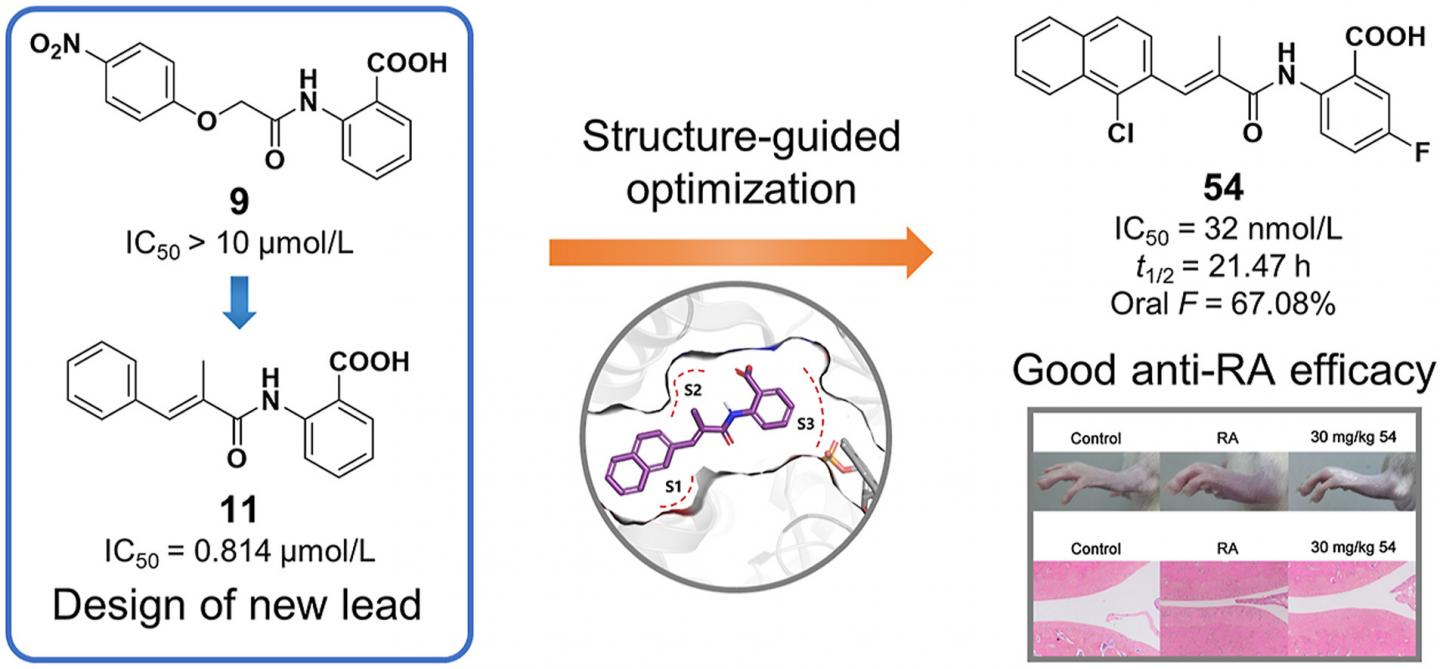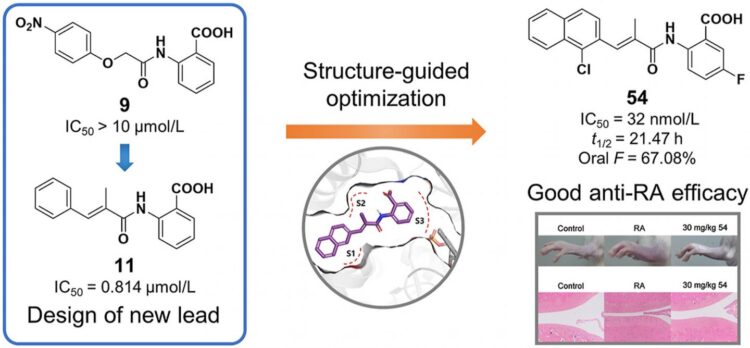
Credit: Acta Pharmaceutica Sinica B
Design, synthesis, molecular modeling, and biological evaluation of acrylamide derivatives as potent inhibitors of human dihydroorotate dehydrogenase for the treatment of rheumatoid arthritis
Human dihydroorotate dehydrogenase (DHODH) is a viable target for the development of therapeutics to treat cancer and immunological diseases, such as rheumatoid arthritis (RA), psoriasis and multiple sclerosis (MS).
The authors designed and synthesized a series of acrylamide-based novel DHODH inhibitors as potential RA treatment agents. 2-Acrylamidobenzoic acid analog 11 was identified as the lead compound for structure-activity relationship (SAR) studies. The replacement of the phenyl group with naphthyl moieties improved inhibitory activity significantly to double-digit nanomolar range. Further structure optimization revealed that an acrylamide with small hydrophobic groups (Me, Cl or Br) at the 2-position was preferred. Moreover, adding a fluoro atom at the 5-position of the benzoic acid enhanced the potency. The optimization efforts led to potent compounds 42 and 53?55 with IC50 values of 41, 44, 32, and 42 nmol/L, respectively.
The most potent compound 54 also displayed favorable pharmacokinetic (PK) profiles and encouraging in vivo anti-arthritic effects in a dose-dependent manner.
###
Article reference: Fanxun Zeng, Shiliang Li, Guantian Yang, Yating Luo, Tiantian Qi, Yingfan Liang, Tingyuan Yang, Letian Zhang, Rui Wang, Lili Zhu, Honglin Li, Xiaoyong Xu, Design, synthesis, molecular modeling, and biological evaluation of acrylamide derivatives as potent inhibitors of human dihydroorotate dehydrogenase for the treatment of rheumatoid arthritis, Acta Pharmaceutica Sinica B, 2021, ISSN 2211-3835, https:/
Keywords: DHODH, De novo pyrimidine biosynthesis, DHODH inhibitors, Acrylamide derivatives, Rheumatoid arthritis
The Journal of the Institute of Materia Medica, the Chinese Academy of Medical Sciences and the Chinese Pharmaceutical Association.
Acta Pharmaceutica Sinica B (APSB) is a monthly journal, in English, which publishes significant original research articles, rapid communications and high-quality reviews of recent advances in all areas of pharmaceutical sciences — including pharmacology, pharmaceutics, medicinal chemistry, natural products, pharmacognosy, pharmaceutical analysis and pharmacokinetics.
For more information please visit https:/
Editorial Board: https:/
APSB is available on ScienceDirect (https:/
Submissions to APSB may be made using Editorial Manager® (https:/
CiteScore: 10.5
Impact Factor: 7.097
5-Year Impact Factor: 7.865
Source Normalized Impact per Paper (SNIP): 2.210
SCImago Journal Rank (SJR): 1.792
ISSN 2211-3835
Media Contact
Morgan lyons
[email protected]
Related Journal Article
http://dx.





